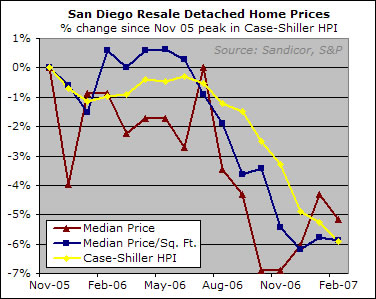It’s simple to track price movements in most financial markets. One share of Coca-Cola stock, to cite one of endless examples, is priced identically to any other share of stock in that company. An ounce of pure gold from one mine is worth the same as an ounce extracted from a mine on the other side of the world.
In contrast, every home is different. Even two houses with identical floorplans in the same neighborhood may have different views, lot sizes, fixtures, traffic noise, landscaping, Indian burial ground proximity… the list goes on.
This lack of fungiblility, as it is known, makes it difficult to determine the changes to a home’s marketable price. If someone sells a share of Coke stock for $50, that means that for the time being, your Coke shares (and everyone else’s, for that matter) are all worth $50. But if someone sells a house down the street for $500,000, that gives you a far more limited idea either about how much people would pay for your house or about what’s happening with home prices in general.
In short, it’s tough to measure changes in home prices with any accuracy. But that doesn’t stop people from trying.


Nice article. It is
Nice article. It is interesting to note that despite it’s well-documented flaws, the median is within <1% of the size-adjusted and the HPI over this 16 month period.
Rich, you speak as if this
Rich, you speak as if this is a true free market. Remember, this is an extremely controlled market, even if the buyer shows up with a wheelbarrow full of cash.
With the vast majority of the population, prices are controlled by the amount of money the mortgage institution will lend, which leads back through the maze of entanglements, apraisors, affordabilty ratios, etc.
As the last couple of years clearly showed, the price of real estate has little to do with the ‘use’ (actual) value of the property, as expressed in currency, but instead with the ‘money value’ of the currency. The actual value of any ‘thing’ really can not be accurately expressed in money terms but only in labor terms. Money only obscurs this relationship, allowing people believe that their house, all things being equal, increases/decreases in value, when what really happens is that their money became worth less/more.
I think you have to understand that the system is a scam, always has been, always will be. It’s just a matter of degree.
I think the fact that there
I think the fact that there is so much variability between homes is all the more reason to strive for a methodology to standardize the housing valuation process. There are a lot of things to consider such as view, lot size, proximity to good schools, kitchen & bathroom fixtures, flooring, etc. However, each one of these things is not entirely intangible. A standard value can be applied by means of a direct monetary value or an indirect index value, that can ultimately be used in factoring the overall home price. Depreciation parameters can also be established for each of these items – e.g., a Berber faucet doesn’t hold its value as well as a Kohler faucet.
There is also variability in automobiles (although not as much), yet there is a Kelley Blue Book value for each based on a set of known variables. If it can be done for automobiles, why can’t it be done for homes?
“The actual value of any
“The actual value of any ‘thing’ really can not be accurately expressed in money terms but only in labor terms.”
I see what you are getting at, but then you have to explain labor. I infer it to mean the buying power people have based on the fruits of their labor. In other words, what they can truly afford. In the past 4 years that has been inflated by loose lending.
The scenario of value of a home vs. value of money is true, but it doesn’t mean it is always a proper relationship. In other words, high price homes may mean a dollar doesn’t go as far, but it doesn’t mean that price is an accurate measure of what is truly affordable.
I agree the system is a scam, but no system can maintain the levels of unaffordability we have today, and the numbers can only hide that for so long. I think that is what Rich is conveying.
If we can agree that the
If we can agree that the actual value of any ‘thing’ is essentially the amount of human labor contained within it, then you can imagine how obscured this value becomes. This economy of ours is so NOT free-market, that to calculate these non-market influences is impossible. Just think of the all the rules and regulations which govern the procurement, building, and selling/buying of a home.
The closest thing there is to a free market is the one for labor because it is in the interest of the ‘haves’ to keep the cost of labor at a minimum, which is exactly what near free-markets do, i.e., minimize the cost of commodities.
Remember, there are over 100K lawyers in Wash DC attempting in every possible way to insure that markets are anything but free. After all, you get what you pay for :).